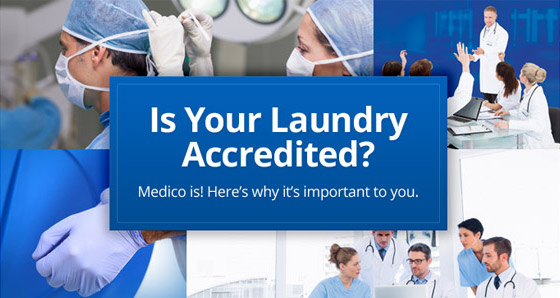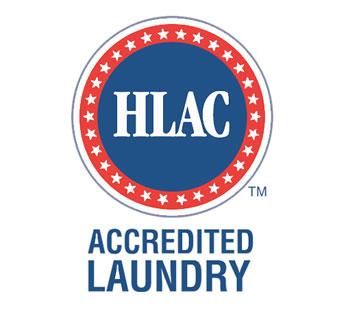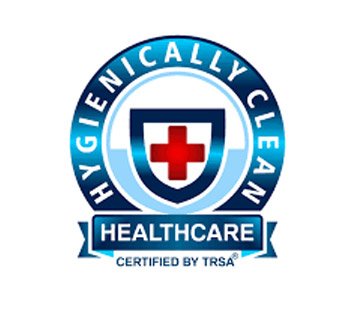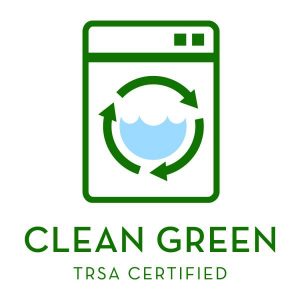

 Healthcare Laundry Accreditation Council
Healthcare Laundry Accreditation Council
The key premise behind HLAC methodology for accreditation is to focus on the process. HLAC inspects a laundry’s processes to ensure that they meet a predetermined standard viewed as the best method of keeping the product clean and free from any danger to the patient.
The process is extensive and includes a review and inspection of the following elements to only name a few:
• Textile specifications and selection, maintenance, and inventory levels
• Laundry facility design, ventilation, and chemical use/management
• Contingency planning, backup, and protocols
• Equipment, preventative maintenance, housekeeping, and operations
• Personnel qualifications, HR policies, hygiene safety, and training
• Customer service policy, contact, and issue procedure
• Quality control, assurance, and monitoring
• Universal precautions, handling, and storage
• Transportation and delivery/pick-up procedures at customer
HLAC examines a laundry’s processes using a detailed checklist of standardized criteria supported by recognized state, federal, and international agencies as well as industry standards. HLAC accreditation is an all-inclusive, on-site inspection of the facility, its processes, procedures, and protocols. On-site inspectors observe the operations, inspect its policies, and question both managers and production staff on the job for compliance. Production staff and managers are interviewed and questioned as to what is done, how it is done, and their role in keeping the laundry clean and safe. The day-long inspection observes operations, equipment, building design, infrastructure systems, and delivery methods.
While internationally there is some reliance on biological testing of healthcare textiles after laundering, there is no universally accepted definition of what is hygienically clean. Currently, there is no consensus from the CDC or EPA on a standard test method for textile hygiene. HLAC believes that testing is useful for quality assurance. HLAC’s process-centric focus reduces the need to rely on sporadic end-product sampling and testing.
HLAC believes that the highest level of assurance can only be provided with a correctly designed and managed laundry and linen program. A thorough review and inspection of the laundry textile process from pick up of soiled linen, processing of the linen, and delivery of the clean product back to the customer provides the best assurance of a hygienically clean product.
 Hygienically Clean Certification
Hygienically Clean Certification
Hygienically Clean believes the microbial measurement of clean laundry is the only true assurance that textiles pose no risk of infection. Hygienically Clean adds outcome measures to structural and process measures long mandated, regulated, or suggested by public and private authorities.
The Hygienically Clean designation assures the safety and cleanliness of textiles rather than certifying only laundry processes. Hygienically Clean is scientifically based. It sets an established threshold that guides the reduction of pathogens on textiles to levels that pose no threat to human illness, according to the Certification Association for Professional Textile Service Administration (CAPTSA). The microbial levels established by CAPTSA and the European Union (EU) for laundered textiles are 20 colony forming units (CFU) per square decimeter for healthcare textiles. This serves as the basis for Hygienically Clean certification.
Hygienically Clean does not certify a facility simply on the basis of following all proper policies and procedures to prevent contamination; it requires consecutive months of independent laboratory testing before certification and ongoing testing to maintain the designation.
Hygienically Clean is the only tool for launderers to implement, the first recommendation for the healthcare industry in the Robert Wood Johnson Foundation/Urban Institute report:
• Decisively move from measuring processes to outcomes
Focusing on outcome measures, the report continues, sparks engagement in broader approaches to quality improvement activities “ideally relying on rapid learning through root cause analysis and teamwork”.
Hygienically Clean encompasses these concepts without ignoring the contribution of specific processes that are associated with achieving better outcomes. Hygienically Clean views every structure and process as an internal tactic, part of a comprehensive approach to achieving good outcomes rather than an end in itself. Hygienically Clean builds upon requirements such as documentation and inspection while adding quantifiable testing of outcomes.
 Clean Green
Clean Green
Clean Green certified linen, uniform, and facility services operations meet quality standards for effectiveness in conserving resources and minimizing environmental impact. Businesses that work with Clean Green certified companies to supply, launder, and maintain linens, uniforms, mats, and other reusable textiles can be assured that their provider maximizes sustainable practices.
Large-scale laundries earn Clean Green standards by using high-capacity washing, drying, and wrinkle-removal equipment that improves efficiency.
To obtain the certification, laundries must document water and energy reduction and deploy best management practices (BMPs) such as:
- Recovering heat from drained hot water and heat dispersed from the process of warming water
- Recapturing drained water from rinses for reuse
- Using environmentally friendly detergents
- Removing solids and liquids from wastewater
- Installing solar energy and energy-efficient lighting
- Recycling programs
- Re-routing trucks to save vehicle fuel
- Implementing preventative maintenance and spill prevention plans






